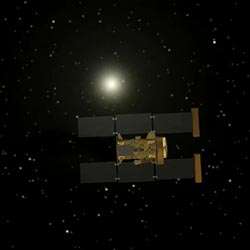Scientists fine-tuning methods for Stardust analysis

On Sunday, January 15, NASA's Stardust mission landed safely with the first solid comet fragments ever brought back to Earth. Members of the mission's Preliminary Examination Team, including several from the Carnegie Institution's Geophysical Laboratory and Department of Terrestrial Magnetism, are among the first to analyze these precious samples. The researchers are refining methods to zero in on organic molecules--the ingredients of life--contained in the grains captured from the coma of comet Wild-2.
The team is already generating preliminary data.
Scientists believe comets like Wild-2 are the oldest solid bodies in the solar system. Yet until now, no one has seen a piece of a comet up close. Researchers expect to retrieve less than one thousandth of an ounce of material from Stardust's collection grid, but this tiny puff of dust might yield scientific gold: by comparing the structure and chemistry of Stardust grains to interstellar dust and rare meteorites rich in organic material, researchers hope to fill in some significant holes in what we know about the evolution and history of our solar system.
"It is likely that some of the carbon in our bodies was originally bound up in comets and delivered to the early Earth through impacts," explained Marc Fries of Carnegie's Geophysical Laboratory, a member of the Preliminary Examination Team. "So when we say that 'we are stardust' we are literally talking about the type of material that Stardust has returned to our laboratories for analysis."
Carnegie's researchers are studying their first Stardust sample with a brand new, $2.8 million NanoSIMS ion probe. This instrument can reveal the chemical makeup of a sample by vaporizing tiny target areas with a stream of ions, allowing an accurate count of the atoms emitted; the NanoSIMS is an ideal tool for analyzing minuscule Stardust grains because it has greater sensitivity than previous ion probes.
The team also plans to study the physical and chemical details of Stardust grains using two different spectroscopic techniques. First, by analyzing laser light reflected from a sample, Raman spectroscopy can reveal both the structure of minerals and the forms of carbon present. Second, a unique soft X-ray microscope at Lawrence Berkeley National Laboratory's Advanced Light Source facility in California enables a technique called XANES spectroscopy, which can help characterize the carbon, nitrogen, and oxygen species in organic matter. Since the carbon-containing materials from Wild-2 are likely to be little changed since the birth of the solar system, these analyses are especially important.
Carnegie researchers from the Geophysical Laboratory and the Department of Terrestrial Magnetism will discuss the analysis of interstellar matter, including early isotopic and spectroscopic results from Stardust, in several talks and posters at the NASA Astrobiology Science Conference (AbSciCon) 2006 at the Ronald Reagan Building in Washington, D.C. March 26-30.
Source: Carnegie Institution
















